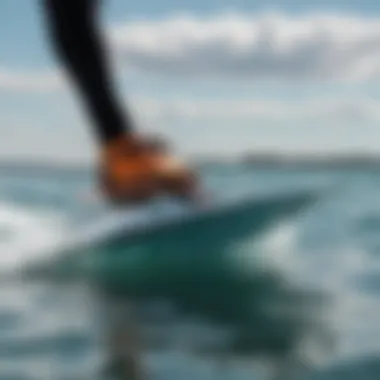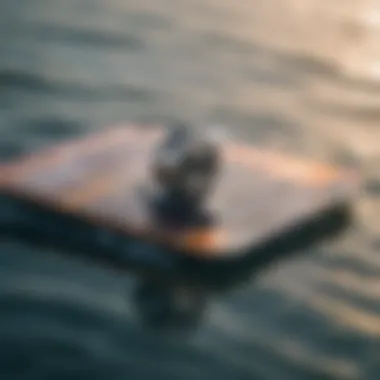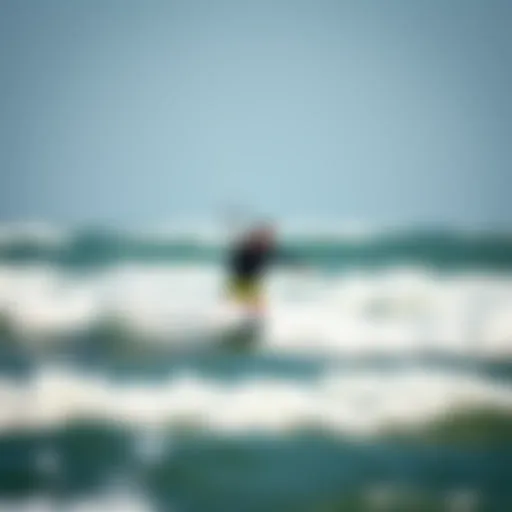Exploring Hydro Foiling Boards for Kiteboarding


Intro
In recent years, hydro foiling has taken the watersports community by storm. Among kiteboarders, this fascinating technology has not just become a niche novelty but has evolved into a preferred method of carving through the water. Hydro foiling boards have captured the interest of both novices and seasoned riders. The concept is simple yet captivating: by using a foil submerged beneath the water, riders can glide above the surface, benefitting from reduced drag and enhanced speed.
The Allure of Hydro Foiling
What sets hydro foiling apart is its unique combination of innovation and performance. Riders often describe an exhilarating sensation of flying over the water, entirely disconnected from the surface noise and turbulence. Whether it’s the satisfaction of mastering the art of balance or the thrill of harnessing wind power more efficiently, hydro foiling is where physics meets the pleasure of sport.
Gaining a foothold in kiteboarding, these boards integrate design elements that allow kiteboarders to experience the sport in a new light. As hydro foiling technology continues to advance, it's essential to dive into various aspects of the gear, techniques, and tips that define this electrifying experience. By understanding what's available and how to effectively use hydro foiling boards, kiteboarders can better appreciate the nuances and intricacies of this sport.
Gear Insights
The world of hydro foiling is teeming with options when it comes to gear. Understanding the various aspects of the gear is foundational, whether you’re just starting out or looking to upgrade your existing equipment.
Latest Gear Reviews
As the market continuously churns out new and innovative hydro foiling boards, it's important to stay updated on which options stand out based on performance, durability, and user feedback. Popular brands like Liquid Force and Slingshot have crafted boards that cater to different skill levels and riding styles.
- Liquid Force Foil Board: Known for its lightweight design, this board offers unparalleled speed and responsiveness. Ideal for transitioning riders seeking an engaging experience on the water.
- Slingshot Hover Glide: This product is lauded for its incredible stability. It’s often recommended for those who want to focus on mastering their maneuvers without the worry of crashing.
Additionally, materials used in the construction of these boards have undergone a transformation. Lightweight carbon fibers and composite materials have replaced traditional heavier boards, making it easier for riders to rise above the water effortlessly.
Essential Gear for Beginners
For those just dipping their toes into the hydro foiling world, having the right gear is crucial. Here are some essentials every newcomer should consider:
- Foil Setup: A reliable set-up that includes a board and foil. Look for easy-to-maneuver options to help you build confidence.
- Safety Gear: A good impact vest and helmet can be lifesavers during those inevitable falls.
- Kite Size: Choose a kite that matches your weight and wind conditions; larger kites can be more challenging to control.
These components will set the stage for a smoother learning curve.
Techniques and Tips
Once equipped with the right gear, it’s time to focus on the techniques that will maximize performance.
Advanced Tricks and Techniques
For those riders ready to take the plunge into advanced territory, mastering tricks like the pump and the jump is essential. Pumping involves using your body weight to create lift and maintain speed. Riders keen on aerial maneuvers should practice their technique on flat water to build muscle memory.
- Learning to Pump: Focus on your stance and rhythm. A steady weight shift can make all the difference.
- Jumping: When you feel comfortable, integrating jump tricks like kite loops can add even more excitement to your rides.
Safety Practices for Kiteboarders
As with any water sport, safety should be paramount. Some practices to consider include:
- Leading with a Spotter: Having a trusted friend on land can help you gauge wind conditions and remove obstacles.
- Understanding Water Conditions: Familiarize yourself with currents and tides before heading out. Dangerous undertows can catch even the most prepared riders off guard.
- Checking Equipment Regularly: Inspect your gear for wear and tear to prevent mishaps during your ride.
By diving into these aspects, kiteboarders can cultivate a deeper understanding of hydro foiling boards while fostering fun and safe experiences.
"Investing in quality gear and knowledge can elevate your hydro foiling experience to new heights."
These tips ensure that riders not only enjoy their time on the water but excel in mastering the craft.
Understanding Hydro Foiling
Hydro foiling represents a significant evolution in the watersports arena. It offers not only a thrilling experience but also a fascinating combination of aesthetics and physics. For those getting their feet wet—with or without a board—it’s crucial to understand the fundamentals of hydro foiling to fully appreciate its beauty and functionality. It isn’t just about gliding atop the water; it’s about harnessing forces, mastering balance, and experiencing a unique form of flight over the liquid surface.
The benefits of understanding hydro foiling extend beyond just technical skills; they touch on safety, performance, and even environmental stewardship. When you grasp how hydro foiling works, you become more adept at making informed decisions about equipment, technique, and conditions, helping you stay safe and enjoy the ride more.
Defining Hydro Foiling
Hydro foiling involves using a board equipped with a hydrofoil—a specialized fin that extends below the water’s surface. As the rider gains speed, the foil generates lift, elevating the board above the water. It’s like magic, but it’s all rooted in physics.
Being aware of this basic definition is your starting point. Hydro foiling is where engineering meets fun. Essentially, it allows you to glide with minimal resistance, leading to an experience that’s smooth, serene, and exhilarating. Participants from various backgrounds have taken a liking to this activity; it attracts thrill-seekers and those who prefer more relaxed outings alike.
The Science Behind Foiling
The mechanics of hydro foiling harness basic principles of aerodynamics and hydrodynamics. Picture this: as the board moves, the hydrofoil interacts with water differently compared to traditional board riding. The faster you go, the more lift the foil generates. This can be fascinating to observers and daunting to beginners.
Here’s a brief look at what happens:
- Lift Generation: Just like an airplane wing working in tandem with air, a hydrofoil uses water to lift the rider above the turbulence of surface waves. The shape and angle of the foil determine how effectively this lift occurs.
- Drag Reduction: Once airborne, resistance diminishes significantly. The board skim over the water, yielding marvelous speeds with less effort.
- Balance and Control: Mastering hydro foiling is all about balance. Adjusting your posture and coordinating your movements enhances lift and control. Too far forward, and you risk a nose dive; too far back, and the tail may snag the water.
Understanding these principles cultivates a deeper appreciation of hydro foiling, making it a rewarding endeavor. You aren't merely riding a wave; you're actively engaging with the physics that govern your glide.
Design and Use of Hydro Foiling Boards
Understanding the design and use of hydro foiling boards is paramount for any kiteboarding aficionado. These boards can significantly augment the rider’s experience on the water, transforming how one interacts with surf and wind. Mastery of hydro foiling not only enhances performance but also elevates the overall enjoyment of the sport. With different types of hydro foiling boards tailored to specific activities, grasping their design intricacies can help kiteboarders choose the right equipment for their skill level and riding style.
Components of a Hydro Foiling Board
Board Shape and Size


The shape and size of a hydro foiling board are crucial factors that determine how the board performs in various conditions. Boards come in various lengths and widths; a typical freeride board might measure between 130cm to 180cm long. A longer board can give more stability, which is beneficial for beginners learning the ropes. Conversely, a shorter board might allow for tight turns and quicker maneuvers, favored by experienced riders.
A unique aspect of board design is its rocker profile, which influences water flow. Boards with a significant rocker can glide more efficiently over choppy waters, while flatter boards suit smoother conditions. However, a high rocker can also reduce speed and tracking.
Foil Configuration
When it comes to foil configuration, this refers to the size, shape, and angle of the hydrofoil itself. A larger foil provides greater lift, making it easier for first-timers, but may feel less responsive. Smaller foils are often more agile but may require more skill to control.
Different foil setups, like high aspect or low aspect ratios, affect maneuverability and cruising style. Choosing the right foil configuration directly impacts performance and enjoyment on the water, impacting speed and control.
Materials Used in Construction
The materials employed in constructing hydro foiling boards range widely, from carbon fiber to stronger polymers. Lightweight materials are key, as they enhance not only performance through speed but also capability to soar above the water surface, contributing to the core experience of hydro foiling. For instance, carbon fiber is robust yet light, making it a popular choice despite its higher price.
However, it is essential to balance durability with weight. Using cheaper materials might result in heavier boards, which could hinder performance. Therefore, understanding their impact on durability and handling is practical knowledge for anyone diving into the hydro foiling world.
Variations in Board Design
Freeride Boards
Freeride boards are known for their versatility, making them suitable for riders keen on cruising smoothly without being tied to one specific style. These boards often have a wider outline, which helps maintain stability. They excel in forgiving diverse conditions, making them ideal for learners and casual riders alike.
One prevalent feature is their flexibility, which absorbs chop and provides a cushioned ride. The downside may be that they aren't the fastest options available, as they prioritize stability over speed.
Race Boards
In contrast, race boards emphasize speed and efficiency. They are engineered to have longer lengths and narrower widths, reducing drag during high-speed runs. Their sleek design allows experienced riders to engage in competitive racing, where efficiency is a must.
Despite their advantages, these boards require precise technique and balance. A novice may find them less forgiving, as stability can diminish at high speeds on rough waters.
Surf Foil Boards
Surf foil boards cater specifically to those who want to ride waves. Characterized by a shorter length and a shape designed to maneuver through surf, they are perfect for navigating ocean conditions. These boards enhance the ride over swells by leveraging the power of waves, engaging riders in a tactile experience not found with flat water.
While they are great for catching waves, their design isn't as versatile in flat water conditions, which could limit their use in certain environments.
Understanding the various components and their functionalities plays a crucial role in selecting a hydro foiling board that best suits one's vision for the experience on the water.
Through careful consideration of these elements—board shape and size, foil configuration, and materials—kiteboarders can find the perfect match that enhances their riding while ensuring safety and enjoyment.
Hydro Foiling Techniques
Hydro foiling techniques play a pivotal role in understanding and mastering this exhilarating sport. They encompass all the elements of starting, refining skills, and pushing the boundaries of hydro foiling. Whether you're just dipping your toes into the waters of hydro foiling or are an experienced kiteboarder looking to enhance your prowess, grasping these techniques is fundamental. Techniques range from how to set up your equipment effectively to executing advanced maneuvers smoothly.
Getting Started with Hydro Foiling
Initial Equipment Setup
When venturing into the world of hydro foiling, the initial equipment setup is as crucial as knowing the tricks. This step sets the groundwork for all your future rides. The primary characteristic of a good initial setup involves the board, foil, and your kite. Ensuring compatibility between these components can greatly influence your overall experience. A proper setup allows riders to maintain stability and control right from the get-go, which is a major key for novices.
A standout feature of the initial setup is the board’s size and shape. Beginners often benefit from larger boards that offer more buoyancy, making it easier to lift off the water. Such boards can greatly decrease the learning curve and promote confidence. However, larger boards can be cumbersome in turns, which can be viewed as a disadvantage once the rider wants to progress.
Entry-Level Techniques
Once you’ve got your equipment ready, jumping into entry-level techniques is the next step. Here, we focus on the fundamental skills needed for a smooth ride. A significant highlight of these techniques is the stance you adopt. Keeping a relaxed yet balanced posture allows for better control as you start foiling.
A unique feature of the entry-level techniques is the emphasis on weight distribution. Understanding where to shift your weight while riding can make a world of difference. If your weight leans too far back, you might find yourself submerging the foil, resulting in instability. Conversely, leaning too far forward can lead to a nosedive. This equilibrium is hard-won but tremendously beneficial for beginners looking to avoid early frustrations while learning.
Advanced Riding Techniques
Carving and Turning
As you navigate beyond the basics, mastering carving and turning becomes essential for those wanting to elevate their riding. These techniques focus on efficiently maneuvering the board underfoot while maintaining speed. The key characteristic here is the ability to edge effectively, which serves as a cornerstone for advanced foiling. Learning to carve involves the coordination of your body movements and the board's angle, making seamless turns not only possible but enjoyable.
A unique feature of carving is the way it allows riders to control their speed during turns. It’s a skill that brings forth both thrill and precision, helping riders gain confidence on the water. However, achieving that sophisticated carve often requires practice, and for some, it may be initially challenging to get the hang of it.
Jumping and Stalling
Every hydro foiler dreams of catching air, and jumping is where that dream leaps into reality. This technique not only showcases your skills but also pushes the boundaries of what you can do while up in the air. The key aspect of jumping lies in timing your movements with the kite’s power and your weight shift.
Stalling, on the other hand, is a distinctive ability that comes with experience. It involves maintaining lift while briefly halting your forward momentum, which can lead to breathtaking aerial displays. The unique feature of this technique is its versatility, allowing you to transition into other maneuvers gracefully.
Yet, while jumping can be exhilarating, it’s important to approach it cautiously; mastering this technique can take time and practicing in a safe environment is essential for avoiding unnecessary spills.
Mastering hydro foiling techniques empowers riders to express their individuality and creativity on the water.
Ultimately, the journey of mastering hydro foiling is filled with learning and adapting. Both equipment setup and techniques play a critical role in achieving a thrilling yet safe experience on the water.
Safety Considerations in Hydro Foiling
When it comes to hydro foiling, safety shouldn't take a back seat. Whether you're just getting your feet wet or you're a seasoned rider tearing up the waves, understanding safety is paramount. Hydro foiling, with its unique dynamics, demands a level of caution rarely seen in more traditional water sports. Like riding a bicycle without training wheels, it can be exhilarating but there's also the risk of tumbles and spills. This section will delve into essential safety gear, navigating hazardous conditions, and the fundamental principles that ensure a safer experience on the water.
Safety Gear Recommendations


In the fast-paced world of hydro foiling, the right gear makes all the difference. Equip yourself with safety gear that not only protects but enhances your riding experience.
Wetsuits and Impact Vests
Wetsuits are designed to keep you warm in cooler waters, but they double as an essential safety item. The primary function of a wetsuit is to provide thermal insulation, but it also offers a slight layer of buoyancy, helping you stay afloat in case of an unexpected spill. The material, usually neoprene, conforms to your body, and the tighter the fit, the better the insulation.
Impact vests, on the other hand, serve a different but equally important purpose. These vests feature additional padding to protect your torso from potential impact during falls. Imagine smashing against the water at high speed—an impact vest helps absorb some of that force, safeguarding your ribs and spine.
A common issue with impact vests is that they can sometimes be bulky, which may affect your freedom of movement. Yet, many athletes find the trade-off worth it since staying safe allows for more carefree riding.
Helmets and Leashes
Helmets and leashes are indispensable in the world of hydro foiling. A good helmet protects your head during falls, which are often unpredictable and can lead to serious injuries. The importance of a snug fit cannot be overstated; a helmet needs to be secure without being uncomfortable. Many riders opt for helmets made from high-density foam, providing solid protection while keeping weight to a minimum.
Leashes connect you to your hydro foil setup, ensuring that your board doesn't drift away if you wipe out. Picture yourself tumbling through the waves, only to turn around and see your board floating slowly away—it’s a frustrating scenario. A sturdy leash prevents this mishap, allowing for a quicker recovery after a fall. However, some riders argue that leashes can create additional drag. Finding the right balance between attachment and maneuverability is key.
Navigating Hazardous Conditions
The waters can be unpredictable, often shifting conditions in the blink of an eye. Knowing how to navigate hazardous conditions is essential for any hydro foiler. First and foremost, it's important to assess the environment before heading out; check wind speeds and wave heights to gauge whether conditions are safe for foiling.
Additionally, awareness of other watercraft is crucial. The last thing you want is to collide with a boat or another rider, so always keep a lookout. Engage with fellow riders, as the community can provide valuable tips and a heads-up about changing conditions.
When faced with rough waters, it’s best to err on the side of caution. If the waves are too choppy, or wind gusts are too strong, consider postponing your session to avoid accidents. Remember, hydro foiling should be fun, but safety always comes first.
Maintaining Your Hydro Foiling Board
Keeping your hydro foiling board in tip-top shape is essential for a thrilling and safe ride. Hydro foiling boards, like any specialized equipment, face wear and tear from regular use. If you neglect maintenance, you might find yourself battling unforeseen issues that could take the joy out of your experience on the water. Not to mention, maintaining your board can enhance its lifespan, enabling you to enjoy countless sessions without the woe of early replacements.
Neglecting maintenance can lead to diminished performance and safety hazards. Just imagine gearing up for an epic day at the beach only to realize your gear is not in working order. A small crack or a loose component can turn a fun day into a trip home sulking and pondering over avoidable repairs. Thus, a proactive approach to maintenance brings benefits, including consistent performance, better safety, and even a higher resale value down the line.
Routine Maintenance Practices
Routine maintenance doesn’t have to be a daunting task; it’s often about establishing good habits after each session on the water. Here are a few key practices to consider:
- Rinse After Use: Always rinse your board with fresh water after a session to remove salt, sand, or debris. This prevents corrosion and buildup that can damage components.
- Inspect Regularly: Check for any visible wear and tear. Look for cracks or chips in the board and inspect the foil attachment points. Early detection of issues can save you from larger problems.
- Dry Properly: After rinsing, ensure your board is dried completely before storing it. This will help prevent mold or any long-term water damage.
- Store Wisely: Keep your board in a cool and dry space, away from direct sunlight when not in use. Direct sunlight can degrade materials over time.
By incorporating these straightforward practices into your routine, you can help ensure your hydro foiling board is always ready for action.
Repairing Damaged Components
Even with vigilant maintenance, accidents can happen. Whether it's a harmless ding from a rocky beach or a more severe impact during an adventurous session, knowing how to repair your board is vital. Addressing damage promptly can prevent minor issues from escalating, safeguarding both your investment and your riding experience.
- Assess the Damage: Before jumping into repairs, take a moment to evaluate the extent of the damage. Small scratches can be sanded down, while deeper cracks may require more comprehensive repair work.
- Ding Repair Kits: Investing in a ding repair kit can save you time and hassle. These kits often include fiberglass cloth, resin, and easy-to-follow instructions, proving invaluable for at-home fixes.
- Foil Maintenance: The foil can also experience dings or bends. Inspect the foil closely for damage and fix it with appropriate methods. If you’re unsure, consulting with a professional can prevent future accidents.
- When to Seek Help: Not all repairs should be handled on your own. If the damage appears serious or if you simply feel uncomfortable making repairs, take your board to a qualified professional.
"A stitch in time saves nine"—this old saying rings true for hydro foiling boards too. Immediate repairs can save you from substantial costs later.
Maintaining your hydro foiling board requires a blend of regular upkeep and knowledge about repairs. Following these practices can prolong your board's life and ensure that each ride is as exhilarating as the last.
Exploring the Market: Brands and Models
When it comes to hydro foiling boards, navigating the market can feel a bit like being dropped in the ocean without a compass. With so many brands and models, having a grasp of what’s available is crucial for making an informed decision. Understanding the diversity in styles and technologies is vital, as the right board can enhance your experience on the water. This section will dissect various high-end hydro foil brands and budget-friendly options, making sense of their offerings and what they cater for.
High-End Hydro Foil Brands
High-end brands typically push the envelope in design, materials, and performance. Names like Naish, Slingshot, and F-One have earned their stripes by delivering products that often set the benchmark in the industry.
- Naish – Renowned for their innovation, Naish boards often feature state-of-the-art materials which enhance durability and performance. Their hydro foils are crafted to ensure superior lift and stability, allowing riders to take their skills to new heights.
- Slingshot – Known for their user-friendly designs, Slingshot offers boards that cater to both novice and pro riders. Their commitment to quality means that every board is built to withstand the stresses of water sports.
- F-One – This brand is famous for its versatility. Their boards are designed with cutting-edge technology, improving leeway and control. Riders often rave about how F-One foils glide effortlessly over water, making them a popular choice.
These high-end brands do come at a price, but the investment often pays back in performance and longevity. Riders looking to up their game will find that these boards can significantly enhance their hydro foiling experience.
Budget-Friendly Options
For those just dipping their toes into hydro foiling, budget-friendly options can provide a softer landing. Brands like Airush and CrazyFly offer affordable boards without compromising too much on quality.
- Airush – This brand’s offerings typically come with manageable prices while still delivering decent performance. The Airush foil boards are known for being user-friendly and versatile, making them suitable for beginners or those who paddle for leisure rather than sport.
- CrazyFly – With an aim to cater to riders of all levels, CrazyFly provides cost-effective boards that hold their own against the pricier counterparts. Their designs often combine reliable materials with a tailored shape that appeals to a wider audience.
Investing in a budget-friendly board might seem like a temporary solution, but it allows newcomers to gain confidence and master techniques before stepping up to more advanced options.
Finding the right board is not just about the brand or cost; it’s about the experience you want to create on the water.
Environmental Impact of Hydro Foiling
Understanding the environmental impact of hydro foiling is crucial in today’s world, where we are more conscious than ever about our influence on nature. Hydro foiling as a sport not only provides exhilaration but also has elements that can harm or help the environment. Acknowledging the balance between enjoying water sports and preserving marine habitats is paramount. This section aims to shed light on sustainable practices in foiling as well as assessing the impact of the sport on marine ecosystems, providing kiteboarders with an all-rounded view.
Sustainable Practices in Foiling
In recent years, the emphasis on sustainability has gained traction within the hydro foiling community. This focus is not just about reducing waste or recycling gear; it also extends to the conscious selection of equipment and practices that minimize environmental footprints.
One pertinent approach is the use of environmentally friendly materials in the construction of hydro foiling equipment. Manufacturers are moving towards bio-resins, recycled plastics, and sustainably sourced woods, reducing reliance on petroleum products and the associated carbon emissions.
Additionally, promoting responsible practices while on the water can make a considerable difference. Here are some suggestions:


- Respect Wildlife: Always give marine life a wide berth. Avoid areas where animals are known to congregate, and never disturb their habitat.
- Stay on Designated Areas: Stick to designated riding areas to avoid damaging sensitive ecosystems, such as coral reefs or seagrasses.
- Proper Waste Disposal: Carry a trash bag while foiling, cleaning up any litter you come across, even if it’s not yours.
- Eco-Friendly Transport: Consider how you get to your foiling destination. Use shared transport when possible or choose vehicles that are fuel-efficient.
Investing in high-quality gear that lasts longer also contributes to sustainable practices. A well-cared-for board can provide years of enjoyment, thus reducing the frequency of replacements.
Impact on Marine Ecosystems
Hydro foiling, like many other water sports, interacts with marine ecosystems in various ways. Foil boards are designed to skim over the water rather than plow through it, which can limit the disruption to marine life compared to traditional watercraft. However, it’s essential to recognize that they are not without their impacts.
The two notable effects on marine ecosystems include:
- Disturbance of Habitat: Although hydro foiling is generally less intrusive, care must be taken to avoid shallow areas where sensitive creatures such as sea turtles and juvenile fish thrive. Riding too close to shore or in estuaries can inadvertently disturb spawning grounds.
- Noise Pollution: Interestingly, the sound created while hydro foiling tends to be less than that of jet skis or motorboats. Nonetheless, the noise from multiple riders can disrupt the natural behaviors of marine creatures, particularly cetaceans and other sensitive species.
"Engaging responsibly with our environment ensures that future generations can also enjoy the beauty and adventure of hydro foiling."
Awareness and consideration in addition to following principles of eco-friendly riding can help ensure that hydro foiling continues to thrive alongside healthy marine ecosystems. The balance we strike today will shape the enjoyment of this exhilarating sport for years to come.
By incorporating sustainable practices and understanding the effects of our activities, both seasoned kiteboarders and newcomers alike can make a significant difference in preserving our waterways.
The Future of Hydro Foiling
Hydro foiling stands on the brink of transformation. As the technology behind these boards evolves, so does the experience for riders—be it a seasoned kiteboarder or a newcomer aiming to conquer the waves. Understanding the future of hydro foiling is crucial not just for the current generation of enthusiasts but also for the upcoming tide of watersport lovers. The progress we witness today hints at innovations that can redefine how we surf the water. It's a fascinating intersection of technology, design, and environmental consciousness.
Innovations on the Horizon
The potential for innovation in hydro foiling is vast. We are seeing more integration of advanced materials that boost performance while reducing weight. Imagine boards constructed with carbon fiber composites that provide both stiffness and buoyancy—finding that sweet spot between durability and performance is key. Moreover, we can’t overlook the rise in electric hydro foils. These boards allow the user to fly above water without the need for traditional propulsion methods, giving an experience that feels almost out of this world.
Some other exciting innovations might include:
- Smartboards: Incorporating sensors for real-time feedback, allowing riders to optimize their performance on the fly.
- AI-enhanced training tools: Using augmented reality to provide lessons while on the water, helping riders to refine their techniques in real-time.
- Eco-friendly materials: As awareness grows about environmental impacts, we might see more boards made from sustainable materials, changing the way the industry approaches production.
With all this on the table, the possibilities seem endless.
Predicted Trends in the Industry
Looking ahead, a few trends appear to be on everyone’s lips in the hydro foiling community. First off, expect an increase in diversity of designs tailored to specific conditions. Boards designed for ocean waves versus those ideal for lakes will become more commonplace, suiting the needs of localized riders. The push for versatility in performance—being able to switch seamlessly from a relaxing afternoon gliding on calm waters to tackling challenging tides—could become a focal point.
- Increased participation: With better gear and more accessible lessons, we might see an explosion of new riders, creating a larger, vibrant community.
- Sponsorship and competitive events: As more enthusiasts emerge, the demand for competitions will rise, pushing brands to invest in pioneers and pros, thereby motivating innovations through competition.
- Community engagement: Social media platforms, such as Reddit and Facebook groups, will serve as gathering spots for tips, experiences, and the sharing of ideas; these spaces hold the potential for real-time collaboration on gear design and riding techniques.
In short, the future of hydro foiling isn’t just about riding—it’s about creating an experience that resonates with watersport enthusiasts at all levels. Staying ahead of these trends will not only enrich one’s time on the board, but also foster genuine community within this burgeoning sport.
"The future belongs to those who believe in the beauty of their dreams." - Eleanor Roosevelt
Embracing what lies ahead, both in terms of technology and community, may well be the path to greater adventures in hydro foiling.
Hydro Foiling and Kiteboarding Synergy
The relationship between hydro foiling and kiteboarding has been nothing short of transformative in the watersport scene. The essence of this synergy lies in how both disciplines complement each other, bringing about an exhilarating experience that goes beyond traditional kiteboarding.
The Integration of Hydro Foiling in Kiteboarding
Hydro foiling offers kiteboarders a unique way to exploit the wind's power. With the addition of a foil, riders can glide smoothly above the water's surface. This not only reduces drag but allows for higher speeds and more fluid movement. More experienced riders are finding that their skills translate well to hydro foiling. The learning curve may present challenges, yet it encourages kiteboarders to refine their techniques.
- Efficiency in Wind Usage: One of the most notable benefits is how hydro foiling enables kiteboarders to harness lighter winds. Riders can maintain speed and enjoy longer sessions even when wind conditions aren’t ideal.
- Elevated Experiences: The feeling of soaring above the water changes the perception of kiteboarding. Riders often describe the sensation as floating, which is only possible with a hydrofoil. This new perspective reinvigorates enthusiasm for the sport, attracting both athletes and leisure seekers alike.
However, the integration of hydro foiling does come with considerations. The amount of equipment involved can get a bit hefty, and learning to maneuver the foil requires practice. Safety becomes paramount, as falling from a height above the surface poses risks.
Community and Share Experiences
The buzz around hydro foiling is creating a vibrant community of enthusiasts eager to share their experiences. Social media platforms like Facebook and Reddit have countless groups dedicated to hydro foiling. Here, riders swap stories, tips, and videos that capture their riding adventures, fostering a sense of camaraderie.
"The community is like a family; you share tips, and everyone celebrates your victories. It's not just about riding but also building connections."
The rise of hydro foiling has spurred the formation of local gatherings and meetups. Riders come together not only to foil but also to exchange equipment advice and experiences. Such interactions can help newbies feel welcome, as they navigate their entry into this thrilling discipline.
The proliferation of video content showcasing tricks and setups serves as a valuable resource for both beginners and seasoned riders. Watching others tackle challenges provides a sense of belonging and sparks inspiration for personal improvement.
As the sport continues to evolve, the community's role remains pivotal. This collective passion enhances the overall experience of hydro foiling and kiteboarding, making it a shared journey of discovery and adventure.
Frequently Asked Questions
Understanding the most common inquiries around hydro foiling is crucial, as it sheds light on the intricacies of this rapidly evolving sport. This section aims to address the typical doubts and queries enthusiasts often face, ranging from equipment specifications to safety protocols. By clarifying these points, the intention is not just to inform, but to build a stronger foundation of knowledge for both newcomers and seasoned riders alike. Having clear answers can enhance the overall experience of hydro foiling, minimize risks, and ultimately lead to more enjoyable sessions on the water.
Common Misconceptions
Hydro foiling can lead to various misunderstandings. Let’s tackle a few:
- Complexity: Many believe hydro foiling is only for the pros. In reality, with the right guidance and equipment, even beginners can have a go.
- Cost: While some boards can set you back a pretty penny, many affordable options exist that still deliver great performance.
- Safety: There's a notion that hydro foiling is inherently dangerous. Like all sports, understanding safety gear and local conditions can mitigate risks significantly.
These misconceptions often deter individuals from experiencing the thrill of hydro foiling or influence them into making poor choices regarding gear or techniques.
Technical Queries from Riders
In the realm of hydro foiling, technical questions frequently arise, especially among those eager to optimize their setup. Some of the common queries include:
- What size board is ideal? Factors such as your weight, riding style, and skill level dictate the board size. A larger board might provide stability, while a smaller board often means more agility.
- How do I choose the right foil? The choice of foil shape and size pivotal for performance. For instance, a larger front wing can enhance lift, making it easier to get airborne, while a smaller wing offers speed but requires more skill to control.
- What adjustments can I make for my riding style? Riders often wonder how they can customize their setups, like adjusting the back footstrap position or fine-tuning foil height. These tweaks can influence the overall handling and performance of the setup.
"Riders should never hesitate to experiment and fine-tune their equipment. Small changes can often yield significant enhancements in performance."
With these insights, it becomes clear that tapping into the wealth of information surrounding these queries can pave the way for more informed decisions and a deeper understanding of the hydro foiling experience.















